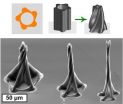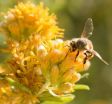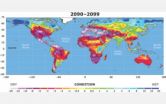(Press-News.org) HOUSTON -- (Oct. 19, 2010) -- Some bacteria react to the cold by subtly changing the chemistry of their outer wall so that it remains pliable as temperatures drop. Scientists identified a key protein in this response mechanism a few years ago, but the question of how bacteria sense cold in the first place remained a mystery. Based on a study by scientists at Rice University and Argentina's National University of Rosario, the answer is: They use a measuring stick.
The study, published in the September issue of Current Biology, involved a series of intricate experiments on the bacteria Bacillus subtilis. The researchers found a specialized protein that protrudes through the bacteria's outer cell wall acts as a measuring stick that's tuned to give a signal when temperatures outside the cell drop.
Scientists have long known that cells use specialized proteins called "transmembrane" proteins to sense and react to the outside world. Transmembrane proteins protrude through the cell's outer wall, or membrane.
"All living cells have the ability to respond to external stimuli, but in most cases that we are aware of, signal recognition -- the event that triggers the response -- occurs when a transmembrane protein binds physically to another chemical outside the cell," said study co-author Ariel Fernandez, research professor at Rice.
Fernandez said the Bacillus subtilis study is one of the first to determine how a transmembrane protein can respond indirectly to a physical stimulus outside the cell. The research was highlighted in review articles in both Current Biology and Nature Reviews Microbiology.
He and colleagues examined a transmembrane protein called DesK (pronounced des-KAY). In previous studies, scientists had found that DesK responded to cold temperatures by causing the cell to make a special compound that keeps the membrane pliable. Without the compound, the fatty acids inside the cell wall become more rigid as temperatures fall.
Fernandez and colleagues found that the part of the DesK protein that protrudes outside the cell contains a sensitized tip. As long as the tip remains in contact with water molecules outside the cell, DesK remains switched off. As temperatures fall and the cell membrane becomes more rigid, the membrane also becomes thicker. As it thickens, it engulfs the sensitized end of the temperature probe, cutting off contact with water molecules outside the cell. This, in turn, activates DesK and sends the signal to release the cold-protecting chemicals. This mechanism, which Fernandez named the buried buoy trigger, was proposed by Fernandez and probed experimentally by the Argentinean team.
The molecular biology and experimental probes were conducted in the laboratory of Diego de Mendoza at the National University of Rosario in Rosario, Argentina. To confirm the findings, the group constructed versions of DesK proteins of varying lengths. Using these as longer or shorter measuring sticks, the researchers confirmed that the signaling mechanism was triggered based upon whether the tip of the transmembrane sensor remained in contact with water molecules outside the membrane.
INFORMATION:
Co-authors of the research include Larisa Cybulski, Mariana Martin and Maria Mansilla, all of the National University of Rosario. The research was supported by the National Institutes of Health, Argentina's National Scientific and Technical Research Council, Argentina's National Agency for Science and Technology Promotion and the Howard Hughes Medical Institute.
Bacteria gauge cold with molecular measuring stick
US, Argentinean scientists: Bacteria respond indirectly to cold
2010-10-20
ELSE PRESS RELEASES FROM THIS DATE:
Osteoporosis drug builds bone in patients with gum disease
2010-10-20
ANN ARBOR, Mich.---A drug marketed to grow bone in osteoporosis patients also works to heal bone wounds in gum disease patients, a University of Michigan study suggests.
"This new approach for the treatment of periodontal disease could allow us to rebuild some of the bone that is lost due to periodontal disease, which until this point has been very difficult to achieve," said Jill Bashutski, clinical assistant professor at the U-M School of Dentistry and first author on the study. "Current treatments to re-grow bone around teeth affected with gum disease have limited ...
A middle class that copes by shopping secondhand
2010-10-20
Conventional wisdom holds that people try to mimic the behavior of the next social class above their own.
Except when it comes to shopping at secondhand stores and yard sales, concludes a new study by Brigham Young University sociology students and faculty.
The study found that high-income shoppers scour the secondhand market for antiques, but everyone else is trying to stretch the family dollar.
"Middle-class shoppers were looking for furniture, some appliances, clothes, things that you could argue are necessities," said BYU sociology professor Ralph Brown. "There's ...
UT professor defines play, discovers even turtles need recess
2010-10-20
Seeing a child or a dog play is not a foreign sight. But what about a turtle or even a wasp?
Apparently, they play, too.
In fact, according to Gordon Burghardt, a psychology professor at the University of Tennessee, Knoxville, many animals -- not just dogs, cats, and monkeys -- need a little play time.
"I studied the behavior of baby and juvenile reptiles for many years and never saw anything that I thought was play. Then I had an epiphany when I saw Pigface, a Nile softshell turtle, batting around a basketball at the National Zoo in Washington, D.C. I realized ...
New clinical trial explores role of vitamin D in preventing esophageal cancer
2010-10-20
CLEVELAND – In a first-of-its-kind clinical trial, physicians at University Hospitals (UH) Case Medical Center who are Case Western Reserve University School of Medicine researchers are exploring the role of Vitamin D in preventing esophageal cancer. Principal Investigator Linda Cummings, MD, along with Amitabh Chak, MD, and Gregory Cooper, MD, from the UH Digestive Health Institute, is recruiting patients with Barrett's esophagus to measure the effects of Vitamin D on protein levels that may influence the risk of developing esophageal cancer.
"Vitamin D is being studied ...
Intricate, curving 3-D nanostructures created using capillary action forces
2010-10-20
ANN ARBOR, Mich.---Twisting spires, concentric rings, and gracefully bending petals are a few of the new three-dimensional shapes that University of Michigan engineers can make from carbon nanotubes using a new manufacturing process.
The process is called "capillary forming," and it takes advantage of capillary action, the phenomenon at work when liquids seem to defy gravity and travel up a drinking straw of their own accord.
The new miniature shapes, which are difficult if not impossible to build using any material, have the potential to harness the exceptional mechanical, ...
Gene activity in the brain depends on genetic background
2010-10-20
SEATTLE, Wash.—October 18, 2010—Researchers at the Allen Institute for Brain Science have found that the same genes have different activity patterns in the brain in individuals with different genetic backgrounds. These findings may help to explain individual differences in the effectiveness and side-effect profiles of therapeutic drugs and thus have implications for personalized medicine. The study is available in this week's online early edition of the Proceedings of the National Academy of Sciences (www.pnas.org).
In this study, the authors compared where in the brain ...
See no shape, touch no shape, hear a shape?
2010-10-20
Scientists at The Montreal Neurological Institute and Hospital – The Neuro, McGill University have discovered that our brains have the ability to determine the shape of an object simply by processing specially-coded sounds, without any visual or tactile input. Not only does this new research tell us about the plasticity of the brain and how it perceives the world around us, it also provides important new possibilities for aiding those who are blind or with impaired vision.
Shape is an inherent property of objects existing in both vision and touch but not sound. Researchers ...
Sniffing out shoe bombs: A new and simple sensor for explosive chemicals
2010-10-20
CHAMPAIGN, Ill. — University of Illinois chemists have developed a simple sensor to detect an explosive used in shoe bombs. It could lead to inexpensive, easy-to-use devices for luggage and passenger screening at airports and elsewhere.
Triacetone triperoxide (TATP) is a high-powered explosive that in recent years has been used in several bombing attempts. TATP is easy to prepare from readily available components and has been difficult to detect. It defies most standard methods of chemical sensing: It doesn't fluoresce, absorb ultraviolet light or readily ionize.
The ...
Old bees' memory fades; mirrors recall of mammals
2010-10-20
A study published Oct. 19 in the open access journal Public Library of Science (PLoS) ONE, shows that not just human memories fade. Scientists from Arizona State University and the Norwegian University of Life Sciences examined how aging impacts the ability of honey bees to find their way home.
While bees are typically impressive navigators, able to wend their way home through complex landscapes after visits to flowers far removed from their nests, the study reveals that aging impairs the bees' ability to extinguish the memory of an unsuitable nest site even after the ...
Drought may threaten much of globe within decades
2010-10-20
The United States and many other heavily populated countries face a growing threat of severe and prolonged drought in coming decades, according to results of a new study by National Center for Atmospheric Research (NCAR) scientist Aiguo Dai.
The detailed analysis concludes that warming temperatures associated with climate change will likely create increasingly dry conditions across much of the globe in the next 30 years.
The drought may reach a scale in some regions by the end of the century that has rarely, if ever, been observed in modern times.
Using an ensemble ...
LAST 30 PRESS RELEASES:
Why nail-biting, procrastination and other self-sabotaging behaviors are rooted in survival instincts
Regional variations in mechanical properties of porcine leptomeninges
Artificial empathy in therapy and healthcare: advancements in interpersonal interaction technologies
Why some brains switch gears more efficiently than others
UVA’s Jundong Li wins ICDM’S 2025 Tao Li Award for data mining, machine learning
UVA’s low-power, high-performance computer power player Mircea Stan earns National Academy of Inventors fellowship
Not playing by the rules: USU researcher explores filamentous algae dynamics in rivers
Do our body clocks influence our risk of dementia?
Anthropologists offer new evidence of bipedalism in long-debated fossil discovery
Safer receipt paper from wood
Dosage-sensitive genes suggest no whole-genome duplications in ancestral angiosperm
First ancient human herpesvirus genomes document their deep history with humans
Why Some Bacteria Survive Antibiotics and How to Stop Them - New study reveals that bacteria can survive antibiotic treatment through two fundamentally different “shutdown modes”
UCLA study links scar healing to dangerous placenta condition
CHANGE-seq-BE finds off-target changes in the genome from base editors
The Journal of Nuclear Medicine Ahead-of-Print Tip Sheet: January 2, 2026
Delayed or absent first dose of measles, mumps, and rubella vaccination
Trends in US preterm birth rates by household income and race and ethnicity
Study identifies potential biomarker linked to progression and brain inflammation in multiple sclerosis
Many mothers in Norway do not show up for postnatal check-ups
Researchers want to find out why quick clay is so unstable
Superradiant spins show teamwork at the quantum scale
Cleveland Clinic Research links tumor bacteria to immunotherapy resistance in head and neck cancer
First Editorial of 2026: Resisting AI slop
Joint ground- and space-based observations reveal Saturn-mass rogue planet
Inheritable genetic variant offers protection against blood cancer risk and progression
Pigs settled Pacific islands alongside early human voyagers
A Coral reef’s daily pulse reshapes microbes in surrounding waters
EAST Tokamak experiments exceed plasma density limit, offering new approach to fusion ignition
Groundbreaking discovery reveals Africa’s oldest cremation pyre and complex ritual practices
[Press-News.org] Bacteria gauge cold with molecular measuring stickUS, Argentinean scientists: Bacteria respond indirectly to cold


